There is nothing more satisfying than having fun with your dog in the yard on nice green grass. Adding a dog four-legged member to the family doesn’t mean you have to sacrifice a lush green lawn. With this ultimate guide to the toughest dog lawn grass to meet the needs of your four legged friend so you can have a nice green lawn and a dog.
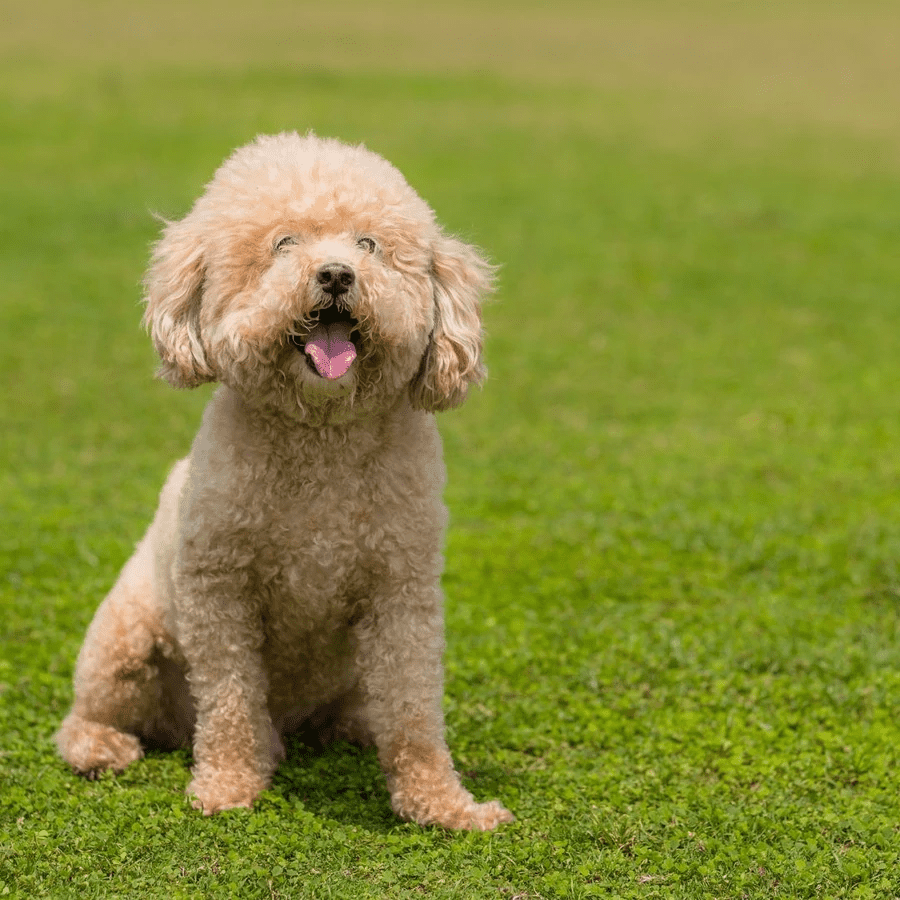
The type of grass you choose for your yard can have a big impact on its appearance and ability to withstand the wear and tear that comes with owning a dog.
With some forethought, your yard can stay lush and green despite your dog’s sometimes harsh treatment that is if you pick the correct lawn grass type from the get go.
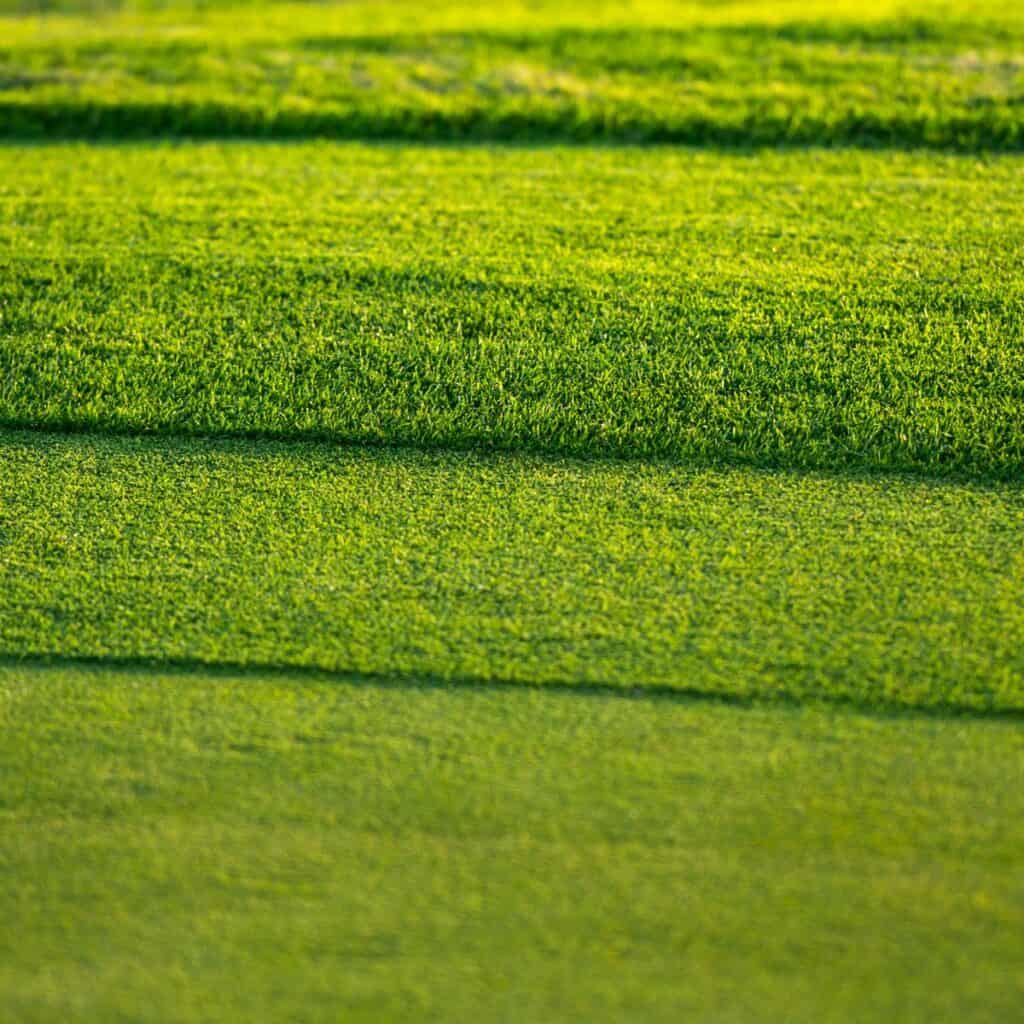
But first . . .should you even choose natural grass? Perhaps synthetic will meet your needs better?
Which Grass is best for dogs: Natural Grass vs Synthetic (Artificial Grass)?
Both synthetic and natural grass are viable options for your yard. Making the right decision depends on your preferences, time, and resources. Your dog will feel little difference between the natural and artificial grass during his playtime but one of the important differences between natural and artificial grass is the type of maintenance and the level of care along with the potential heat and smell.
You need to spend more time and effort on taking care of the natural grass but artificial grass can hold smells from dog urine and does have a tendency to get hot in summer months at the same time you are trying to keep your dogs cool.
Artificial or synthetic grass for dogs is usually non-absorbent and is made from plastics and anti-microbial fibers. It usually has proper drainage features that make your lawn look beautiful and clean.
However, we have also found that without regular cleaning it tends to hold doggie smells and needs to rinsed and washed regularly.
We also noticed an off gassing particularly in the warmer summer months. A plastic smelling aroma seemed to emanate from the grass. We could not help but consider that the off gassing, which did seem to dissipate with the age of the grass, was not healthy for our pets or children. However, at the same time the risk of dog exposure to pesticide and herbicides are reduced.
Finally, we live in a warmer part of the world, namely, central California, although there are plenty of hotter places on the planet, on hotter days the grass is very uncomfortable for dogs and they do not elect to lie on it from midday through the evening. So, if you do live in an area where there are hotter days you will need to ensure that your dog has somewhere else other than artificial grass to relax.
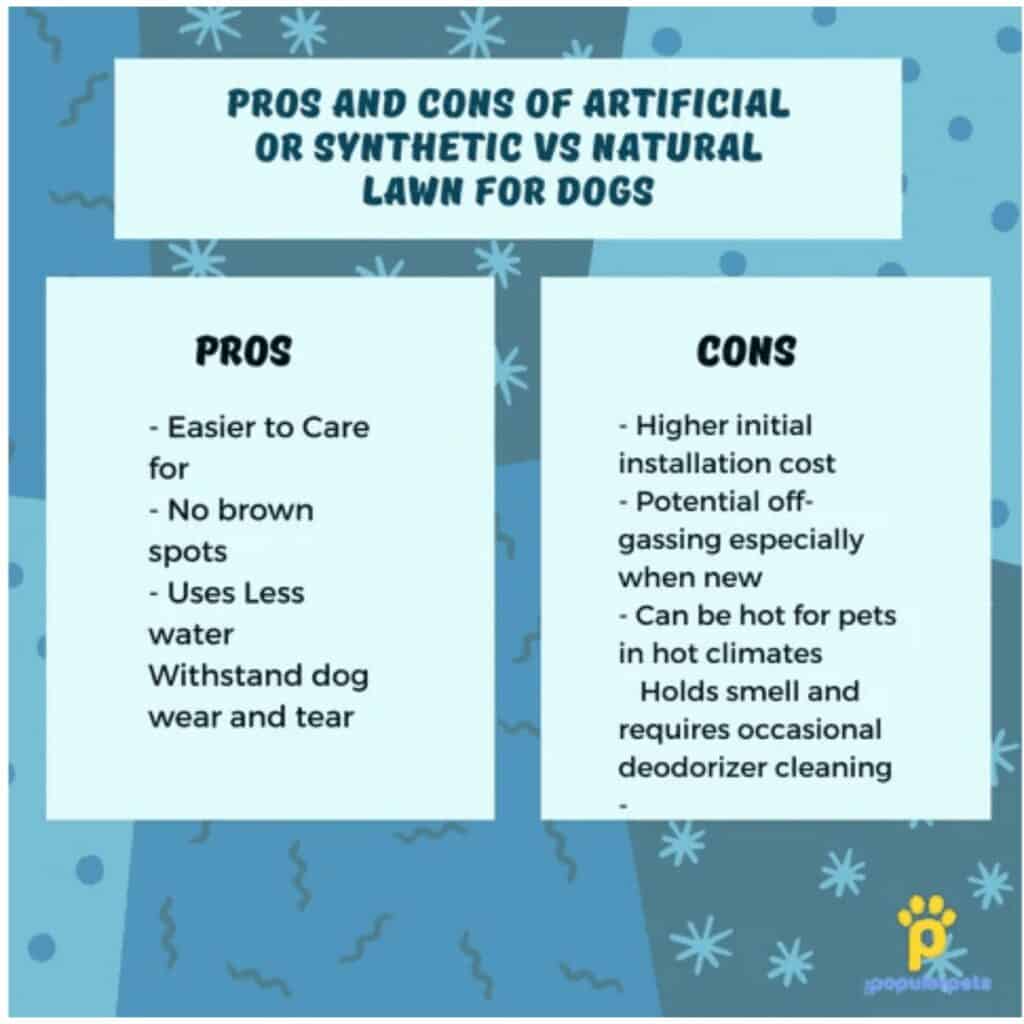
If you like to spend your time taking care of the grass, you definitely need to go with the natural grass. However, if you want to have perfect-looking grass and are not concerned with heat or smell you need to go with artificial grass.
Common Grass Types for Dog Lawns
When it comes time to replace the lawn in the backyard. There are a variety of different grass types for dog lawns. Different varieties of grasses have different features which may make them better or worse for dog lawns. These features include their hardiness and ability to withstand traffic and brown spots making them more superior varieties for dog lawns. The following varieties are among the most commonly used for dog lawns.
Fescue Dog Lawn Grass Variety
Fescue grass has become one of the most common grass varieties in the United States and is a popular selection for dog lovers. Planting fescue grass into your yard will keep your lawn green all year long.
Tall Fescue is generally cool-season grass and stays green all year long. It’s very low maintenance and usually looks great with little effort on your part.
This grass requires fewer pesticides and has shown strong resilience to insects and is well-suited for yards with dogs. This grass is very absorbent and can easily handle a large dog’s urine making it very popular among dog lovers.
Find out more about how to prevent brown spots in your yard in our article on Seven Ways to Prevent Brown Spots on Dog Lawns.
Zoysia Grass Variety for Dog Lawns
Zoysia is a dense-growing grass and can tolerate wide temperature variations. This dense and luxurious grass is perfect for high paw-traffic and is another dog lawn grass variety that is used often by dog lovers. It’s widely used for lawns in temperate climates and thrives in warm-season variety. It is even less prone to weeds due to its dense turf.
Zoysia is a pretty slow grower, tolerant of lawn traffic, like paws prints, and is well-suited for yards with dogs. This slow growth pattern also means that this grass needs less mowing.
Zoysia generally requires less fertilization and is less vulnerable to insect and fungus damage, depending upon the environmental conditions. This grass can handle shady areas pretty well. Dogs love to roll in the soft grass, and Zoysia grass feels luxurious. So, if you’ve got a yard with a shade and a pooch, this could be a good option.
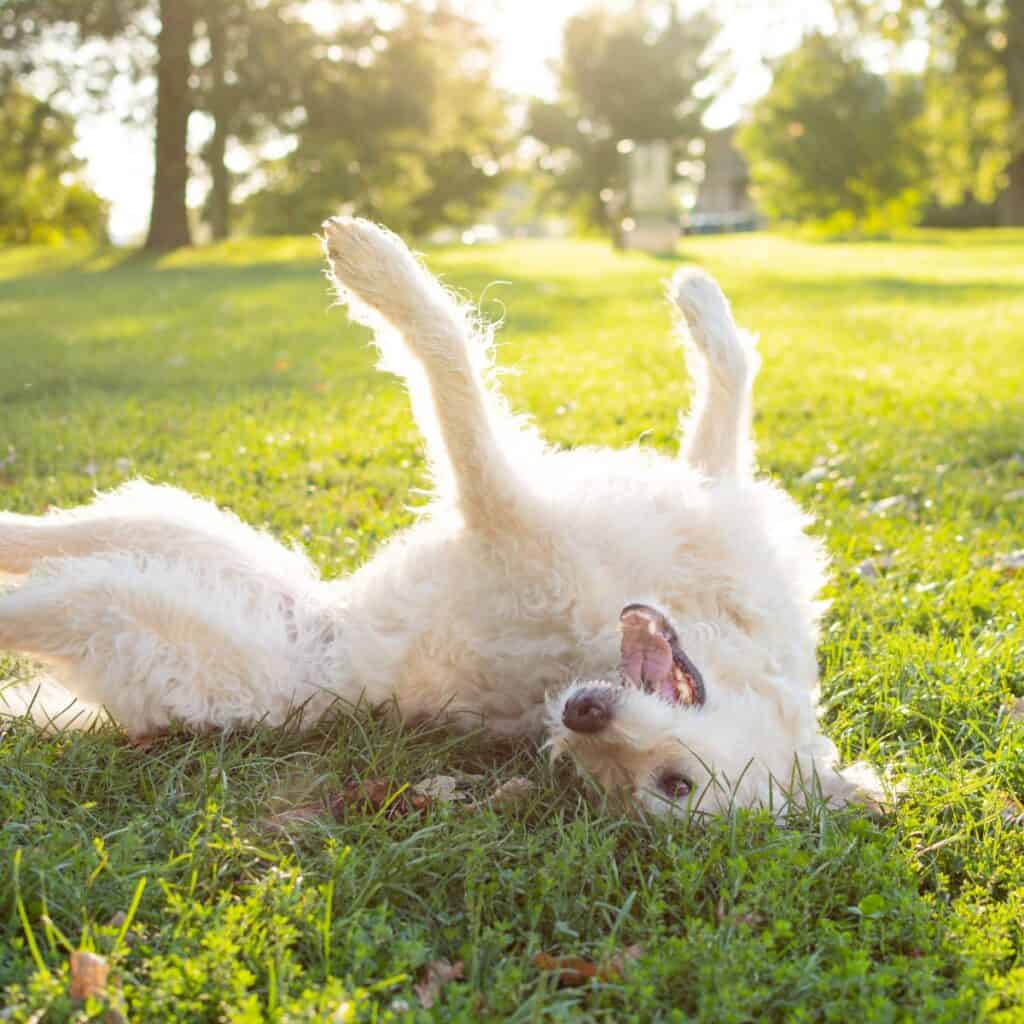
Perennial Ryegrass Lawn for Dogs
When looking for the best grass for someone with dogs Perennial Ryegrass grass is another great option. It does very well in cooler climates and stays a beautiful green color in mild winters.
Given the proper conditions, this grass germinates faster than any other lawn grass seed. Southern lawn owners keep lawns green in winter by seeding perennial ryegrass over existing warm-season lawns in the fall.
Perennial Ryegrass is hardy and tolerant of dog urine, making it a great choice for dog lawns if you have a large dog or own multiple dogs. Perennial Ryegrass does require more water and fertilizer than other grasses making it ecofriendly choice for dog lovers as well.
Kentucky Bluegrass for Dog Lawns
Kentucky bluegrass is another grass variety that is frequently used by dog lovers for their dog lawns. This popular, fast-growing, fast healing, thick grass is up to the challenge of your dog’s racing paws. It grows well in most climates and does very well in colder areas.
Besides its ability to heal from roughhousing or your pup’s potty breaks, it also makes a very attractive looking lawn with its unique blue-hued blades of grass.
Centipede Grass for Dog Lawns
Centipede grass requires specific growing conditions to thrive. It needs more acidic soil than most grasses. This grass makes a wonderful option for standing up to your dog’s urine due to its love for more acidic soils and hardiness.
Centipede grass does well in hot climates but needs plenty of water to thrive. If you are in the United States, the best option is to plant Centipede grass in the Southeast. With these higher watering requirements, your pet’s urine will be diluted and less likely damage your lawn.
The increased need for water makes centipede grass a less drought tolerant and less ecofriendly selection for your dog lawn.
Bermuda Grass for your Dog Lawn
Bermuda grass is your dog’s other BFF and is a popular choice among those living in warm climates. It rarely needs supplemental irrigation and is perfect for dog owners with sunny yards.
Bermuda grass has deep roots which make it incredibly resistant to drought, weeds, and your dog’s running path. Regular maintenance and weekly watering help maintain its appearance. The Bermuda grass tends to turn brown during the winter when temperatures drop and will come back to life once warm weather returns. At this point some people over seed with another variety to keep their dog lawn looking green.

Bermuda grass is perfect for high dog-traffic areas since it’ll usually tolerate your dog’s paws pretty well. Bermuda grass is often the choice for high traffic horse polo fields to give you a sense of how tough it is. The grass can combat pet urine and lawn damage However, like all other grasses, it’ll appreciate a break from time to time to heal and recolonize bare areas.
Important Features of Grass for Dogs
Some of the primary things you want to look for include:
- Rapid growth rate: All lawns will suffer some damage when your dog runs, jumps, and plays on them. You can’t do much about it. The best way to keep your lawn looking perfect is to select a grass that grows quickly because it’ll help it recover from the damage quickly.
- Deep root development: Grasses that have deep root systems will tend to weather damage better and recover more quickly. Additionally, deeply rooted grasses will sometimes discourage digging behaviors.
- Well-matched to your climate: Give your lawn the perfect look throughout the year by choosing one that is well-suited to your climate. The grass should get the ideal amount of sun exposure.
Which Grass Do Dogs Eat?
Dogs usually need a little grass in their diets, which is actually another drawback to using only synthetic grasses for dog lawns. However, if you have a synthetic or artificial lawn you can grow intermediate wheatgrass and allow your furry friend to snack on it regularly.
Dogs eat all types of grasses but prefer fresh clean green grass the most. When dogs are seeking grass to eat they are trying to clear their stomach or add nutrients to their diet and seek the greenest and freshest grass available, this can be any variety of grass that is green and fresh.
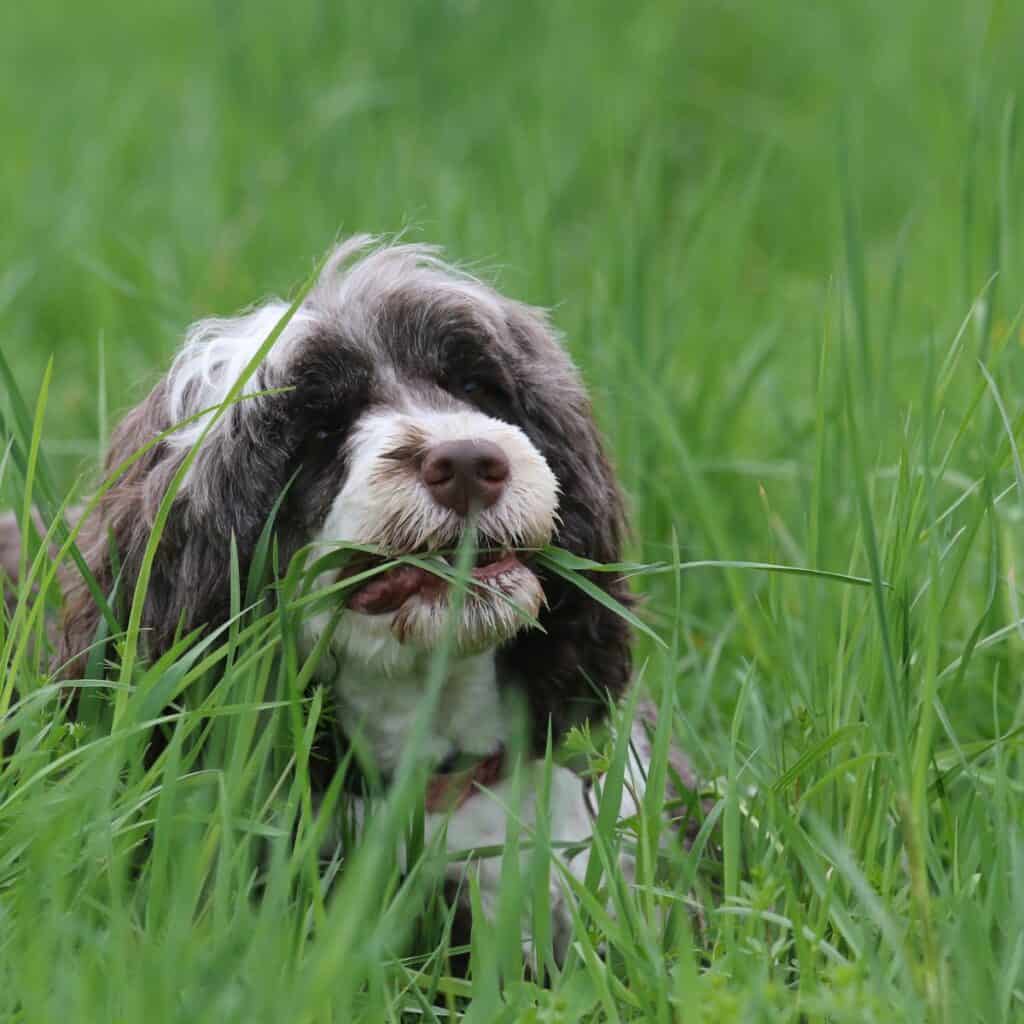
Best grass for dogs with allergies?
The best grass for dogs with allergies is grass that has not been treated with any fertilizers or pesticides. These chemicals can cause allergy issues for your dog. Along with itchy skin and irritated eyes, fertilizers and pesticides can cause actual poisoning if the dogs eat the grass or lick their paws after playing in fertilized grass.
Best Grass for Dogs Where You Live
When choosing the best grass for dogs, you should consider the climate you live in, the pH level of your soil, and the possible watering schedule you can commit to. With that in mind there are several recommendations specific to your geography for instance you may want Kentucky bluegrass in Colorado, and warm season grasses like Zoysia in the Southeast.
Best Grass for Dog Lawns in Colorado
Kentucky bluegrass is a good choice for many situations and uses and for dog lawns in Colorado. It’s the most widely used lawn grass in Colorado. Local growers produce high-quality bluegrass sod.
If you want to seed a bluegrass lawn, it is best to sow a blend of two to five Kentucky bluegrass cultivars in late August to early September. Other grasses that generally work well for Colorado lawns are buffalo grass, blue grama, turf-type tall fescue, fine-bladed rescued.
Best Grass for Dog Lawns in Texas
Warm-season grasses are ideal for Texas heat and humidity. Grasses that generally work well for Texas lawns are Zoysia, Bermuda, and St Augustine.
Best Grass for Dog Lawns in Florida
The three lawn types that stand up to dogs in Florida are Bermuda, Zoysia, and Bahia. All three of these options are good for high paw-traffic and are good selection for dog lawns in Florida. These varieties are hardy and tolerant of dogs running and playing. They make life just that much easier and more beautiful for dog parents in Florida.
Best Grass for Dogs Southern California
Southern California presents optimal climates with mild winters, periods of drought can last for weeks at a time. The grass you choose fir your dog lawn should be drought resistant and drought tolerant.
Bermuda grass can survive and thrive in dry, hot climates. It’s a great choice for home lawns that endure a lot of paw traffic given its hardiness and root system. When looking for a cool-season variety, you will usually find blends of fescue and ryegrass.
Final Thoughts on Dog Lawns
The best type of grass for your dog four-legged companion, regardless of how he ultimately makes use of it, is not only chemical-free but well-maintained. With these grass types, you can easily keep your lawn looking great and your dog happy at the same time!
What grass type do you use in your yard? Have you experienced any challenges when having fun with your dog in the yard? Share your experience with us. We would be happy to hear from you.
We talk everything about neighborly relations and pettiquette in your neighborhood when it comes to lawns in Motherpuppin’ Adorable: What to do when your dog is better than everyone else’s
Check out our article on 7 Tips for Keeping Brown Spots from your Dog Lawn
Dog Grass or Lawn FAQs
Dog potties need to withstand some wear and tear. Hardy grasses like ryegrass or fescue grass are great for dog lawns and potties.
Dogs can eat all types of real grasses. If you are planting a grass patch for your dog you may want to try a wheatgrass patch which is easy to grow and full of nutrients.
Dogs can eat grass for many reasons including satisfying a need or desire for extra nutrients. Sometimes dogs eat grass so that they will vomit. Read more about dogs eating grass and vomiting here.
Ryegrass and Fescue are the most urine-resistant type of grass, while Kentucky Bluegrass and Bermuda are the most sensitive
It may depend on the region that you live in but if tall fescue and perennial ryegrass grow well where you live then those are both great selections for high traffic dog areas.
Again, depending on where you live certain grasses may not grow as well but grasses that are good for shade and dogs are tall fescue and perennial ryegrass.
Keeping your grass free from dog urine spots can be difficult but choosing a hardy grass to resist urine spots will help such as Perennial Ryegrass which is hardy and tolerant of dog urine, making it a great choice if you have a large dog or own multiple dogs.

